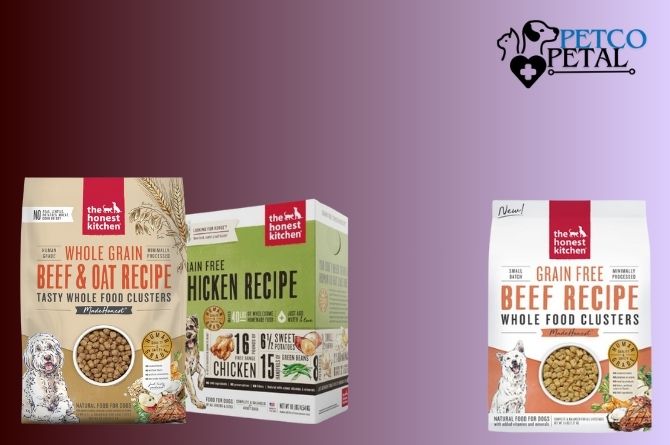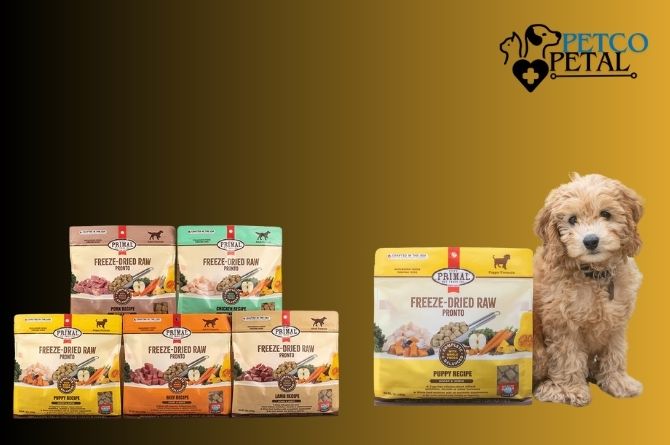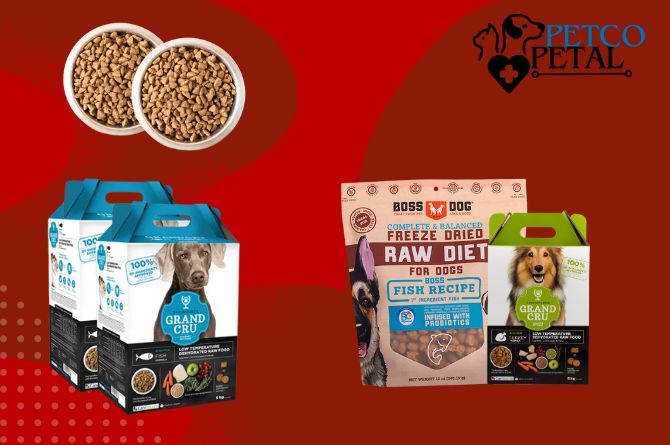Introduction
As pet owners become more mindful of the health and well-being of their dogs, finding the right type of food is crucial. One option that has gained considerable attention in recent years is dehydrated dog food. This type of dog food offers a balance between convenience and nutrition, making it an appealing choice for pet parents who want to feed their dogs high-quality meals without sacrificing time.
Dehydrated dog food is made by gently removing moisture from fresh ingredients, preserving vital nutrients while extending shelf life. Unlike traditional kibble, which often contains preservatives and fillers, dehydrated dog food retains the natural flavors and nutritional content of the raw ingredients. This makes it an increasingly popular option for dog owners who want a more natural, nutritious choice for their pets.
What is Dehydrated Dog Food?
Dehydrated dog food is a type of pet food made by removing moisture from fresh ingredients through a gentle drying process. This method ensures that essential nutrients, vitamins, and minerals are preserved while extending the food’s shelf life. Unlike freeze-dried or canned food, dehydrated dog food requires rehydration before feeding, making it an ideal option for those looking for a natural, minimally processed meal for their pets.
The process of making dehydrated dog food starts with whole, fresh ingredients like meats, vegetables, and grains. These ingredients are slowly dehydrated at low temperatures to remove the water content, while still retaining their nutritional integrity. When it’s time to feed your dog, all you need to do is add water to rehydrate the food, making it resemble fresh or homemade meals.
The benefits of dehydrated dog food go beyond just nutrition. Its long shelf life makes it easy to store without the need for refrigeration, and its lightweight nature makes it convenient for travel or storage in small spaces. Additionally, since the food retains most of its original nutrients, it provides dogs with a wholesome, nutrient-dense diet without the artificial preservatives and additives commonly found in other types of dog food.
Why Choose Dehydrated Dog Food for Your Pet?
There are several compelling reasons to choose dehydrated dog food for your furry companion. Not only does it provide significant health benefits, but it also offers convenience and versatility for pet owners.
One of the main advantages of dehydrated dog food is its nutritional density. Since the moisture is removed while the ingredients are fresh, the food retains more of its natural nutrients compared to highly processed options like kibble. This means your dog gets a wholesome, nutrient-rich meal that supports their overall health, without the need for synthetic additives or preservatives. Many dog owners prefer dehydrated dog food because it retains more of the natural nutrients, ensuring their pets receive the best possible diet.
In addition to its health benefits, dehydrated dog food is incredibly convenient for pet owners. It takes up less space than traditional dog food, is lightweight, and has a longer shelf life, making it easy to store and transport. Whether you’re traveling or just want to save space at home, this option fits seamlessly into busy lifestyles.
Lastly, dehydrated dog food is suitable for a variety of dogs, including those with allergies or sensitivities. Since the ingredients are minimally processed and often include whole foods, it’s easier to avoid common allergens and provide your pet with a cleaner, more digestible meal.
Top 5 Best Dehydrated Dog Foods of 2024
When it comes to choosing the best dehydrated dog food for your pet, it’s essential to find products that offer high-quality ingredients, nutritional value, and ease of preparation. Here’s a review of the top 5 dehydrated dog foods of 2024:
1. The Honest Kitchen Dehydrated Dog Food Review

Pros: Human-grade ingredients, no preservatives, suitable for all life stages.
Cons: Requires time for rehydration, and can be more expensive than traditional kibble.
Standout Features: The Honest Kitchen is well-known for using 100% human-grade ingredients, ensuring that your pet gets the highest quality food possible. This dehydrated dog food is made from organic fruits and vegetables, free-range chicken, and other nutrient-packed ingredients. It’s particularly great for dogs with food sensitivities due to its simple, clean ingredient list.
2. Spot & Tango Unkibble Dehydrated Dog Food Review

Pros: Customizable meal plans, fresh ingredients, no artificial additives.
Cons: Limited flavors available, higher cost.
Standout Features: Spot & Tango’s dehydrated dog food stands out for its personalized meal plans, tailored to your dog’s specific nutritional needs. Their meals are made with fresh, whole ingredients and are free from artificial preservatives or fillers. This makes it a great option for dog owners who want something customizable and healthy for their pets.
3. Primal Pet Foods Dehydrated Dog Food Review

Pros: High in protein, uses free-range meats, grain-free.
Cons: Can be expensive for larger dogs.
Standout Features: Primal Pet Foods’ dehydrated dog food is perfect for pet owners looking for a raw-inspired diet. With a focus on free-range meats and organic produce, this brand offers a highly nutritious option packed with protein. It’s also grain-free, making it suitable for dogs with grain allergies or sensitivities.
4. Dr. Harvey’s Canine Health Dehydrated Dog Food Review

Pros: Holistic, made from 100% real foods, customizable by adding your own protein.
Cons: Requires the addition of protein, time-consuming to prepare.
Standout Features: Dr. Harvey’s dehydrated dog food is designed to be a base mix, allowing you to add your own choice of protein. This is perfect for dog owners who want more control over their pet’s diet. Made with 100% real foods like vegetables and grains, this product is packed with vitamins and minerals.
5. Sojos Complete Dehydrated Dog Food Review

Pros: Easy to prepare, affordable, and available in various flavors.
Cons: Contains grains, not suitable for dogs with grain allergies.
Standout Features: Sojos Complete dehydrated dog food is a great budget-friendly option that still offers high-quality ingredients. It’s easy to prepare by simply adding water, and the food is ready in minutes. Available in multiple flavors, it caters to picky eaters as well.
How to Choose the Best Dehydrated Dog Food for Your Pet

Choosing the right dehydrated dog food for your pet involves considering several important factors to ensure it meets their nutritional and health needs. Here are some key aspects to keep in mind when making your decision:
Nutritional Content
The nutritional content of dehydrated dog food is one of the most critical factors to consider. Look for options that offer a balanced amount of protein, healthy fats, vitamins, and minerals. Protein should be one of the main ingredients, as it supports muscle health and overall energy. Vitamins and minerals are equally important for maintaining a healthy coat, strong bones, and a robust immune system. Always check the ingredient list to ensure that the food contains high-quality, whole ingredients without unnecessary fillers or artificial additives.
Consider Your Dog’s Size, Age, and Health Needs
Your dog’s size, age, and specific health requirements play a significant role in determining the best-dehydrated dog food. Puppies, for example, need food rich in calories and nutrients to support their growth, while senior dogs may benefit from food with fewer calories and added supplements for joint health. Similarly, large-breed dogs might require a higher protein intake compared to smaller breeds. If your dog has any allergies or sensitivities, look for dehydrated dog food that’s free from common allergens like grains or dairy.
Suitability for Special Diets
If your dog requires a special diet, such as grain-free, limited-ingredient, or raw-inspired meals, make sure to choose a dehydrated dog food that aligns with these needs. Many brands offer tailored options to cater to dogs with specific dietary restrictions or preferences. Additionally, some dehydrated foods allow you to add your own protein, giving you even more control over what your dog eats.
By considering these factors, you can find the perfect dehydrated dog food that supports your pet’s overall health and well-being.
Dehydrated Dog Food vs. Other Types of Dog Food
When selecting the right food for your pet, it’s essential to understand the key differences between dehydrated dog food and other types of dog food, such as kibble, wet food, and raw food. Here’s how they compare in terms of shelf life, nutritional benefits, and preparation time.
Dehydrated Dog Food vs. Kibble
One of the most significant differences between dehydrated dog food and traditional kibble is the ingredients. While kibble is often highly processed and contains preservatives to extend its shelf life, dehydrated dog food offers more natural ingredients with fewer preservatives. Because the moisture is removed from the food, dehydrated dog food also has a long shelf life, without the need for artificial chemicals. Additionally, dehydrated dog food typically retains more of the original nutrients, which may be lost during the high-heat processing of kibble.
However, kibble is more convenient for busy dog owners as it doesn’t require rehydration before feeding, unlike dehydrated dog food, which needs water added before serving.
Dehydrated Dog Food vs. Wet Food
Wet food offers a soft texture and higher moisture content, which can be beneficial for dogs that don’t drink much water. However, compared to wet food, dehydrated dog food offers the benefit of better portability and shelf life. Wet food often needs to be refrigerated and consumed quickly once opened, while dehydrated dog food can be stored for extended periods without refrigeration.
Nutritionally, wet food can be high in fats and calories, making dehydrated dog food a healthier option for dogs who need to maintain a balanced diet without excessive calories.
Dehydrated Dog Food vs. Raw Food
Raw food diets are becoming more popular among dog owners who want to provide a diet closer to what dogs might eat in the wild. However, raw food requires careful handling to avoid bacterial contamination, and it needs to be stored in a freezer. In contrast, dehydrated dog food provides similar nutritional benefits to raw food, without the mess or the risk of bacteria. The gentle dehydration process retains many of the nutrients found in raw food, while also offering the convenience of longer shelf life and easier preparation.
How to Prepare Dehydrated Dog Food
One of the key benefits of dehydrated dog food is how simple it is to prepare. With just a few easy steps, you can serve your dog a healthy, nutritious meal. Here’s a step-by-step guide on how to rehydrate and prepare dehydrated dog food:
Step 1: Measure the Food
Start by measuring the appropriate amount of dehydrated dog food based on your dog’s size and weight. Most packaging will provide feeding guidelines, but as a general rule, one cup of dehydrated food expands to about 1.5 to 2 cups once rehydrated.
Step 2: Add Water
Once you’ve measured the food, add water. Typically, you’ll need to add an equal amount of water to the food. For example, if you’re preparing one cup of dehydrated dog food, you’ll add one cup of water. Adjust the water quantity based on the desired consistency—some dogs prefer a soupy texture, while others like it thicker.
Tip: Use warm water to help the food rehydrate faster.
Step 3: Wait for Absorption
After adding the water, allow the food to sit for about 5 to 10 minutes. This gives the food time to fully absorb the moisture. As the food rehydrates, it will expand and soften, creating a fresh, ready-to-eat meal for your dog.
Tip: For quicker preparation, stir the food occasionally to help it absorb water evenly.
Step 4: Serve the Food
Once the food has absorbed the water and reached the desired consistency, it’s ready to serve. Make sure to check the temperature if you’ve used warm water—let it cool if it’s too hot for your dog to eat immediately.
Step 5: Adjust Serving Sizes
If your dog is new to dehydrated dog food, start with smaller portions and gradually increase to the recommended serving size. Pay attention to your dog’s appetite and adjust the serving size based on their activity level and nutritional needs.
FAQs About Dehydrated Dog Food
Is dehydrated dog food better than dry kibble?
Both dehydrated dog food and kibble have their benefits, but many pet owners prefer dehydrated food for its natural ingredients and minimal processing. Unlike kibble, which is often highly processed and packed with preservatives, dehydrated dog food retains more nutrients, making it a healthier option for dogs.
How long does dehydrated dog food last?
Unopened dehydrated dog food can last for months or even years, thanks to the moisture removal process. Once rehydrated, it should be consumed within a day or refrigerated for up to 2-3 days. Always check the packaging for specific storage instructions.
Can I mix dehydrated dog food with other food types?
Yes, you can mix dehydrated dog food with other food types such as kibble, wet food, or homemade meals. This can help diversify your dog’s diet and make the transition to dehydrated food easier for picky eaters.
Conclusion
In summary, dehydrated dog food offers numerous benefits, including superior nutritional content, fewer preservatives, and convenience. It’s a fantastic option for dog owners who want to provide a healthy, natural diet for their pets while enjoying the long shelf life and ease of preparation. Whether you’re looking for a high-quality alternative to kibble or just want to explore more natural food options for your pet, dehydrated dog food is worth considering.
For dog owners looking for a healthy, natural option, dehydrated dog food is a fantastic choice.

